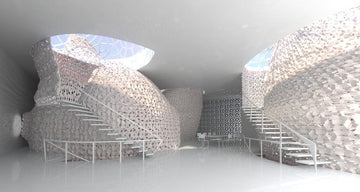3D printing, also known as additive manufacturing, is a revolutionary technology that is transforming various industries, from manufacturing and healthcare to fashion and architecture. In this beginner's guide, we will delve into the fundamentals of 3D printing, exploring the underlying technology, different printing methods, and the diverse range of materials used. Whether you're new to 3D printing or curious about this cutting-edge technology, this guide will unravel the essentials of additive manufacturing and its wide-ranging applications.
The Technology Behind 3D Printing:
At its core, 3D printing is an additive process, where three-dimensional objects are created by depositing material layer by layer, guided by a digital model or design. The process begins with the creation of a 3D model using computer-aided design (CAD) software or 3D scanning technologies. The 3D model is then sliced into thin horizontal layers, which serve as a blueprint for the 3D printer.
Different Printing Methods:
There are several 3D printing methods, each with its own unique approach and applications. The most common 3D printing methods include:
- Fused Deposition Modeling (FDM): This method involves feeding thermoplastic filament through a heated nozzle, which extrudes the material layer by layer to create the object. FDM is widely used due to its affordability and accessibility, making it an excellent choice for beginners and hobbyists.
- Stereolithography (SLA): SLA uses liquid photopolymer resin, which is cured layer by layer using an ultraviolet (UV) laser. SLA is known for its high level of detail and surface finish, making it popular in industries like jewelry design and dentistry.
- Selective Laser Sintering (SLS): In SLS, a laser fuses powdered material, such as nylon or metal, layer by layer to create the object. SLS is ideal for producing complex geometries and functional prototypes.
- Digital Light Processing (DLP): Similar to SLA, DLP employs a digital light projector to cure liquid resin layer by layer. DLP offers faster printing speeds, making it suitable for larger projects.
Common Materials Used:
3D printing materials encompass a wide range of options, each with its specific properties and applications. Some common materials used in 3D printing include:
- PLA (Polylactic Acid): PLA is a biodegradable and easy-to-print material derived from renewable resources like cornstarch. It is popular for its low toxicity, making it suitable for hobbyists and educational settings.
- ABS (Acrylonitrile Butadiene Styrene): ABS is a durable and impact-resistant material commonly used in functional prototypes and engineering applications.
- PETG (Polyethylene Terephthalate Glycol-Modified): PETG combines the ease of printing of PLA with the durability of ABS, making it a versatile and widely used material for various projects.
- Resin: Resin materials are commonly used in SLA and DLP printers, offering high detail, smooth surfaces, and a wide range of finishes, including clear and flexible.
- Metals: Advanced 3D printing technologies enable the printing of metals, such as titanium, aluminum, and stainless steel, for aerospace, automotive, and medical applications.
Conclusion:
3D printing is a game-changing technology with a myriad of applications and endless possibilities. Understanding the basics of 3D printing, including its underlying technology, printing methods, and material options, opens up a world of creativity and innovation. Whether you're interested in crafting personalized designs, creating functional prototypes, or exploring architectural visions, 3D printing empowers you to bring your ideas to life with precision and efficiency. As this transformative technology continues to evolve, it will undoubtedly shape the future of manufacturing, design, and problem-solving, making it an exciting journey for both beginners and seasoned enthusiasts alike.





